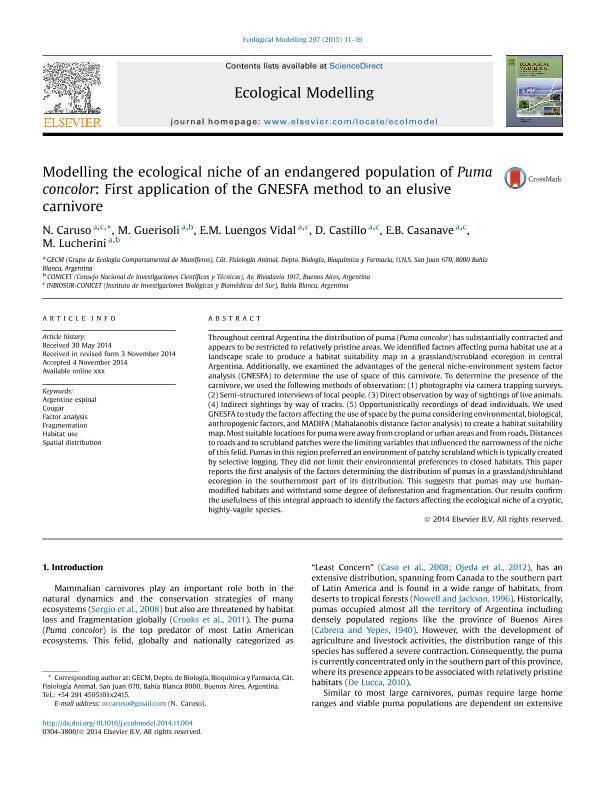Mostrar el registro sencillo del ítem
dc.contributor.author
Caruso, Nicolás

dc.contributor.author
Guerisoli, Maria de Las Mercedes

dc.contributor.author
Luengos Vidal, Estela Maris

dc.contributor.author
Castillo, Diego Fabian

dc.contributor.author
Casanave, Emma Beatriz

dc.contributor.author
Lucherini, Mauro

dc.date.available
2016-07-04T19:19:07Z
dc.date.issued
2015-02
dc.identifier.citation
Caruso, Nicolás; Guerisoli, Maria de Las Mercedes; Luengos Vidal, Estela Maris; Castillo, Diego Fabian; Casanave, Emma Beatriz; et al.; Modelling the ecological niche of an endangered population of Puma concolor: First application of the GNESFA method to an elusive carnivore; Elsevier; Ecological Modelling; 297; 2-2015; 11-19
dc.identifier.issn
0304-3800
dc.identifier.uri
http://hdl.handle.net/11336/6335
dc.description.abstract
Throughout central Argentina the distribution of puma (Puma concolor) has substantially contracted and appears to be restricted to relatively pristine areas. We identified factors affecting puma habitat use at a landscape scale to produce a habitat suitability map in a grassland/scrubland ecoregion in central Argentina. Additionally, we examined the advantages of the general niche-environment system factor analysis (GNESFA) to determine the use of space of this carnivore. To determine the presence of the carnivore, we used the following methods of observation: (1) photographs via camera trapping surveys. (2) Semi-structured interviews of local people. (3) Direct observation by way of sightings of live animals. (4) Indirect sightings by way of tracks. (5) Opportunistically recordings of dead individuals. We used GNESFA to study the factors affecting the use of space by the puma considering environmental, biological, anthropogenic factors, and MADIFA (Mahalanobis distance factor analysis) to create a habitat suitability map. Most suitable locations for puma were away from cropland or urban areas and from roads. Distances to roads and to scrubland patches were the limiting variables that influenced the narrowness of the niche of this felid. Pumas in this region preferred an environment of patchy scrubland which is typically created by selective logging. They did not limit their environmental preferences to closed habitats. This paper reports the first analysis of the factors determining the distribution of pumas in a grassland/shrubland ecoregion in the southernmost part of its distribution. This suggests that pumas may use human-modified habitats and withstand some degree of deforestation and fragmentation. Our results confirm the usefulness of this integral approach to identify the factors affecting the ecological niche of a cryptic, highly-vagile species.
dc.format
application/pdf
dc.language.iso
eng
dc.publisher
Elsevier

dc.rights
info:eu-repo/semantics/openAccess
dc.rights.uri
https://creativecommons.org/licenses/by-nc-nd/2.5/ar/
dc.subject
Argentine Espinal
dc.subject
Cougar
dc.subject
Factor Analysis
dc.subject
Fragmentation
dc.subject
Habitat Use
dc.subject
Spatial Distribution
dc.subject.classification
Ecología

dc.subject.classification
Ciencias Biológicas

dc.subject.classification
CIENCIAS NATURALES Y EXACTAS

dc.title
Modelling the ecological niche of an endangered population of Puma concolor: First application of the GNESFA method to an elusive carnivore
dc.type
info:eu-repo/semantics/article
dc.type
info:ar-repo/semantics/artículo
dc.type
info:eu-repo/semantics/publishedVersion
dc.date.updated
2016-05-10T14:38:17Z
dc.journal.volume
297
dc.journal.pagination
11-19
dc.journal.pais
Países Bajos

dc.journal.ciudad
Amsterdam
dc.description.fil
Fil: Caruso, Nicolás. Universidad Nacional del Sur; Argentina. Consejo Nacional de Investigaciones Cientificas y Tecnicas. Centro Cientifico Tecnológico Bahia Blanca. Instituto de Ciencias Biologicas y Biomedicas del Sur; Argentina
dc.description.fil
Fil: Guerisoli, Maria de Las Mercedes. Universidad Nacional del Sur. Departamento de Biología, Bioquímica y Farmacia; Argentina. Consejo Nacional de Investigaciones Cientificas y Tecnicas. Centro Cientifico Tecnol.conicet - Bahia Blanca. Instituto de Ciencias Biologicas y Biomedicas del Sur; Argentina
dc.description.fil
Fil: Luengos Vidal, Estela Maris. Universidad Nacional del Sur; Argentina. Consejo Nacional de Investigaciones Cientificas y Tecnicas. Centro Cientifico Tecnológico Bahia Blanca. Instituto de Ciencias Biologicas y Biomedicas del Sur; Argentina
dc.description.fil
Fil: Castillo, Diego Fabian. Universidad Nacional del Sur; Argentina. Consejo Nacional de Investigaciones Cientificas y Tecnicas. Centro Cientifico Tecnológico Bahia Blanca. Instituto de Ciencias Biologicas y Biomedicas del Sur; Argentina
dc.description.fil
Fil: Casanave, Emma Beatriz. Universidad Nacional del Sur; Argentina. Consejo Nacional de Investigaciones Cientificas y Tecnicas. Centro Cientifico Tecnológico Bahia Blanca. Instituto de Ciencias Biologicas y Biomedicas del Sur; Argentina
dc.description.fil
Fil: Lucherini, Mauro. Universidad Nacional del Sur. Departamento de Biología, Bioquímica y Farmacia; Argentina. Consejo Nacional de Investigaciones Cientificas y Tecnicas. Centro Cientifico Tecnol.conicet - Bahia Blanca. Instituto de Ciencias Biologicas y Biomedicas del Sur; Argentina
dc.journal.title
Ecological Modelling

dc.relation.alternativeid
info:eu-repo/semantics/altIdentifier/doi/10.1016/j.ecolmodel.2014.11.004
dc.relation.alternativeid
info:eu-repo/semantics/altIdentifier/url/http://www.sciencedirect.com/science/article/pii/S0304380014005626
dc.relation.alternativeid
info:eu-repo/semantics/altIdentifier/doi/http://dx.doi.org/10.1016/j.ecolmodel.2014.11.004
Archivos asociados
